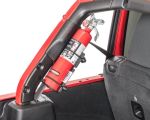How to Check Your Car's Transmission Fluid: A Simple Guide
As a car owner, it’s essential to regularly check the condition of your vehicle's transmission fluid. Doing so ensures smooth gear shifting, avoids potential damage to the transmission system, and extends the life of your car. In this guide, I will walk you through the process of checking your car's transmission fluid, explain why it’s so important, and offer tips for maintaining the optimal fluid levels.

Pick Your Part - Help Yourself
1232 Blinn Ave, Wilmington, CA 90744, USA
1. Why Is Checking Transmission Fluid Important?
Transmission fluid plays a vital role in your vehicle's overall performance. It lubricates the moving parts inside the transmission, ensuring that they function properly and smoothly. Over time, transmission fluid can degrade, leading to potential problems such as slipping gears, rough shifting, or even complete transmission failure. Regularly checking the fluid helps to avoid these issues and ensures your car runs efficiently.

Pick Your Part - Greer
13054 E Wade Hampton Blvd, Greer, SC 29651, USA
2. What You’ll Need to Check Transmission Fluid
Before you begin, gather the following items:
- Car Manual: Different vehicles have different fluid levels and dipstick locations. Always consult your car's manual for specifics.
- Clean Rag or Paper Towel: You’ll need this to wipe off the dipstick and check the fluid condition.
- Funnel (if adding fluid): This will help you add transmission fluid easily and prevent spills.
- Transmission Fluid: Make sure to use the right type as specified in your vehicle's manual.
3. Steps to Check Transmission Fluid
Here’s a step-by-step guide to checking your car's transmission fluid:
- Step 1: Park Your Car on Level Ground - For an accurate reading, ensure that your car is parked on a flat surface.
- Step 2: Start the Engine - Start your engine and let it run for a few minutes to ensure that the fluid is properly circulating throughout the transmission system.
- Step 3: Locate the Dipstick - Open the hood of your car and find the transmission fluid dipstick. In many vehicles, it’s located near the back of the engine bay, often marked with a red or yellow handle. Refer to your car’s manual for the exact location.
- Step 4: Remove the Dipstick - Pull the dipstick out and wipe it clean with a rag or paper towel. Reinsert it fully back into the tube.
- Step 5: Check the Fluid Level - Pull the dipstick out again and check the level of the fluid. The dipstick will have markings indicating the proper fluid level, usually with “Full” and “Low” indicators.
- Step 6: Assess the Fluid Condition - Apart from the level, check the condition of the fluid. Healthy transmission fluid is typically a reddish-pink color and should be clear. If the fluid looks dark or smells burnt, it’s time for a change.
- Step 7: Add Fluid if Necessary - If the fluid is low, add the recommended transmission fluid using a funnel. Be cautious not to overfill, as this can cause problems.
- Step 8: Recheck the Fluid Level - After adding fluid, recheck the level to ensure it’s within the proper range.
4. How Often Should You Check Transmission Fluid?
It’s generally a good idea to check your transmission fluid at least once every 30,000 to 60,000 miles, depending on your vehicle and driving conditions. If you notice any symptoms of low or dirty fluid, such as rough shifting or slipping gears, check the fluid immediately and consider scheduling a transmission fluid change.
5. Common Signs of Transmission Fluid Problems
Besides low levels, there are several signs that your transmission fluid may need attention:
- Slipping Gears: If your car unexpectedly changes gears or hesitates when shifting, it could be a sign of low or dirty fluid.
- Unusual Sounds: Grinding, whining, or clunking noises when shifting gears may indicate fluid issues or internal transmission damage.
- Delayed Shifting: A delay when shifting gears or a jerking motion while driving may suggest problems with the fluid.
- Burnt Smell: Transmission fluid should never smell burnt. If it does, it’s time to replace the fluid and possibly address other issues.
6. Maintaining Your Transmission Fluid
To keep your transmission running smoothly, consider these additional tips for fluid maintenance:
- Use the Right Fluid: Always use the transmission fluid specified in your vehicle’s manual. Using the wrong type of fluid can damage your transmission.
- Regular Fluid Changes: Transmission fluid doesn’t last forever. Over time, it breaks down and collects debris. Follow your manufacturer’s recommended schedule for fluid changes.
- Monitor for Leaks: If you notice a puddle of red fluid under your car, there may be a leak in the transmission system. Have it inspected and repaired promptly.
By keeping your transmission fluid in good condition, you can avoid costly repairs and ensure your car runs smoothly for years to come. If you're ever unsure about checking or replacing your transmission fluid, don’t hesitate to contact a professional mechanic for assistance.




























